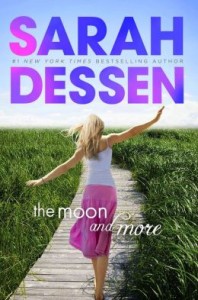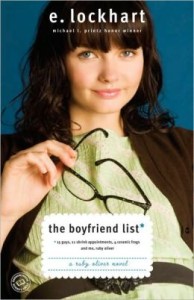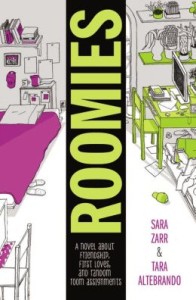If you go back as far as I do, you remember the YA novels before there was any such category as “YA.” These were mostly insipid girl-meets-boy or girl-changes-boyfriend stories that I, little snob that I was, turned up my not-unsubstantial nose at. The other option in the early-teen fiction landscape was series books, chiefly detectives or nurses. Otherwise, “young adults” at the time headed for the adult stacks, where content may include sex and/or violence but not too graphic.
All that has changed, of course—most libraries have carved out space for a separate YA section, meaning that the classification now includes plenty of titles you don’t want your middle-graders and younger to read. The Michael A. Prinz Award list (for excellence in YA) is almost exclusively titles of this type. Award books tend to take on serious issues like loss and alienation, but love never dies—as a perennial theme, that is. One of last years’ most honored YA titles is Eleanor and Park, a bi-racial high school romance that also involves bullying, alcoholism, and parental abuse.
Classic love stories always involve something: some obstacle to be overcome for the lovers to be together, even if only in death (cue “Romeo and Juliet” theme). Sometimes love conquers all, sometimes not—and sometimes, as in classics like Judy Blume’s Forever, it just heaves a sigh and wanders aimlessly away.
Among popular YA authors, Sarah Dessen might be considered the Queen of Teen Romance today. Though her  novels may deal with heavy issues like abusive boyfriends or death of a parent, most of them are new takes on old favorites—particularly Summer Love. The Moon and More, last year’s hit, generated rave reviews and lots of reader-love on Amazon.com, and is in many ways an old-fashioned summer romance. You know the type: heroine reluctantly joins her grandma, great aunt or other difficult or little-known relative for an extended vacation at a remote beach location; experience turns out to be life-changing. Usually because of a boy. The Moon and More is somewhat reassuring in its classic outline, showing that the romance novel is alive and well, though Sarah Dessen has a much better grasp of character than the genre writers of old. One twist on the basic formula is that Emaline, age 17, doesn’t go to the beach—she already lives at the beach where the world comes to her. In her capacity as hostess for her family’s vacation properties she mingles with the tourists—most significantly, a film producer who’s working on a documentary about a local artist who doesn’t want to be documented. The producer is obnoxious, but her assistant, Theo, is a different kettle of fish. Emaline already has a boyfriend, the hunky Luke, whom lady tourists openly slaver over when he’s working shirtless. Triangles are another staple of teen romance, but one sign of the times may be that Emaline doesn’t end up firmly attached to either Luke or Theo. Here’s another sign of the times: Luke groaned in my ear, then rolled off me. That occurs at the beginning of a chapter, with no special emotional significance, and left this this grandma-reader just a little stunned.
novels may deal with heavy issues like abusive boyfriends or death of a parent, most of them are new takes on old favorites—particularly Summer Love. The Moon and More, last year’s hit, generated rave reviews and lots of reader-love on Amazon.com, and is in many ways an old-fashioned summer romance. You know the type: heroine reluctantly joins her grandma, great aunt or other difficult or little-known relative for an extended vacation at a remote beach location; experience turns out to be life-changing. Usually because of a boy. The Moon and More is somewhat reassuring in its classic outline, showing that the romance novel is alive and well, though Sarah Dessen has a much better grasp of character than the genre writers of old. One twist on the basic formula is that Emaline, age 17, doesn’t go to the beach—she already lives at the beach where the world comes to her. In her capacity as hostess for her family’s vacation properties she mingles with the tourists—most significantly, a film producer who’s working on a documentary about a local artist who doesn’t want to be documented. The producer is obnoxious, but her assistant, Theo, is a different kettle of fish. Emaline already has a boyfriend, the hunky Luke, whom lady tourists openly slaver over when he’s working shirtless. Triangles are another staple of teen romance, but one sign of the times may be that Emaline doesn’t end up firmly attached to either Luke or Theo. Here’s another sign of the times: Luke groaned in my ear, then rolled off me. That occurs at the beginning of a chapter, with no special emotional significance, and left this this grandma-reader just a little stunned.
Emaline herself is the result of a beach romance between the handsome city guy and the carefree sun girl, now Emaline’s mother who is happily married to her stepdad. But, “The mistakes you make now count,” she tells her daughter. “Not for everything, and not forever. But they do matter, and they shape you.” Wise advice, though never applied to Emaline’s having sex with Luke, which is treated as no big deal.
 Another way to address teenage love is to make a joke about it, as E. Lockhart does in her Ruby Oliver quartet, all of which include “Boy” in the title (First one: The Boyfriend List). In Ruby’s world everything that can go wrong with dating, does, including Going Too Far, Losing Your Bestie, Being Misunderstood, and Failing at Everything You’re Normally Good at Because You’re So Darn Distracted. Lockhart has her serious moments, but her approach is mostly lighthearted and perhaps that’s the best way to deal with teen crushes—as long as they don’t Go Too Far. Teens have a lot of life ahead of them, and shouldn’t define true love by what they experience in high school. At the same time, though some aspects of sex are funny, it’s not a joke. I wonder if almost as many girls have been laughed out of their virtue as sweet-talked out of it.
Another way to address teenage love is to make a joke about it, as E. Lockhart does in her Ruby Oliver quartet, all of which include “Boy” in the title (First one: The Boyfriend List). In Ruby’s world everything that can go wrong with dating, does, including Going Too Far, Losing Your Bestie, Being Misunderstood, and Failing at Everything You’re Normally Good at Because You’re So Darn Distracted. Lockhart has her serious moments, but her approach is mostly lighthearted and perhaps that’s the best way to deal with teen crushes—as long as they don’t Go Too Far. Teens have a lot of life ahead of them, and shouldn’t define true love by what they experience in high school. At the same time, though some aspects of sex are funny, it’s not a joke. I wonder if almost as many girls have been laughed out of their virtue as sweet-talked out of it.
Sara Zarr’s interests are broader than romance—see her treatment of a young piano prodigy in The Lucy Variations. But her breakout novel, Story of a Girl (2008), takes on all the messes a confused and distraught 16-year-old is likely to get herself into, including sexual messes, with an understanding that includes both sympathy and responsibility. Sex is frankly acknowledged as dangerous and consequence-ridden, resulting in countless tangled webs. The only way out is forgiveness. Zarr’s latest, Roomies, is co-written with Tara Altebrando: a story told between the alternating viewpoints of two girls on opposite coasts who have been assigned as roommates for their upcoming freshman year  at UC-Berkeley. Both are understood in their family context—California Lauren is the oldest of her five younger siblings, all of them born after she had been the only child for a long, long time. She has some resentment issues to deal with, but her parents are picture-book perfect compared to New Jersey Elizabeth’s (a.k.a. EB). EB doesn’t remember her dad, who left to pursue a gay lifestyle in San Francisco, and her mother is so discouraged and desperate she takes up with a married man. Family turmoil forms the backdrop for each girl’s decisions about the guys that turn up in their lives. For the record, Lauren (Zarr’s character) decides against sex with her new boyfriend, while EB (Altebrando’s) gives up her virginity soon after learning about her mother’s new crush. She’s the one who suggests it, not the guy, and her reasons probably have more to do with her mom than with him. In spite of that, the sex turns out to be “pretty great,” with a gratifying emotional response on both sides and no immediate bad consequences. (“We used protection, of course,” she tells Lauren, even though it was a spur-of-the-moment event. Who thought to bring along “protection”?)
at UC-Berkeley. Both are understood in their family context—California Lauren is the oldest of her five younger siblings, all of them born after she had been the only child for a long, long time. She has some resentment issues to deal with, but her parents are picture-book perfect compared to New Jersey Elizabeth’s (a.k.a. EB). EB doesn’t remember her dad, who left to pursue a gay lifestyle in San Francisco, and her mother is so discouraged and desperate she takes up with a married man. Family turmoil forms the backdrop for each girl’s decisions about the guys that turn up in their lives. For the record, Lauren (Zarr’s character) decides against sex with her new boyfriend, while EB (Altebrando’s) gives up her virginity soon after learning about her mother’s new crush. She’s the one who suggests it, not the guy, and her reasons probably have more to do with her mom than with him. In spite of that, the sex turns out to be “pretty great,” with a gratifying emotional response on both sides and no immediate bad consequences. (“We used protection, of course,” she tells Lauren, even though it was a spur-of-the-moment event. Who thought to bring along “protection”?)
It’s hard to tell how extensive sexual experimentation actually is in high school. Judging by contemporary YA novels: very. How extensive is the so-called hookup culture on college campuses? Judging by reports: very. The college trend probably wouldn’t be so pronounced if it hadn’t begun in high school. This view from the other side (in Cosmo, of all places) laments the breakdown of communication between men and women and the distance that casual sex partners put between themselves. Which, the author hastens to assure us, has nothing whatever to do with hookup culture. But I have my suspicions. Should your teenage daughter read some of these books? It depends. If the story presents sex either as inconsequential or the best thing ever, I’d say not. But some, in spite of bad language of a little too much information, can communicate a valuable picture of sex as something worthy of respect and care.
We’ve talked about this a lot. See our posts on the paranormal teen romance, the Christian teen romance, the gay teen romance, and virtuous romance, generally. To catch ‘em even younger, see Emily’s thoughts on God’s Little Princess and similar books. See also our recommendations for Valentine’s Day, here and here.
Support our writers and help keep Redeemed Reader ad-free by joining the Redeemed Reader Fellowship.
Stay Up to Date!
Get the information you need to make wise choices about books for your children and teens.
Our weekly newsletter includes our latest reviews, related links from around the web, a featured book list, book trivia, and more. We never sell your information. You may unsubscribe at any time.
We'd love to hear from you!
Our comments are now limited to our members (both Silver and Golden Key). Members, you just need to log in with your normal log-in credentials!
Not a member yet? You can join the Silver Key ($2.99/month) for a free 2-week trial. Cancel at any time. Find out more about membership here.
3 Comments
Leave a Comment
You must be logged in to post a comment.


Even though I’m in the target range for YA, although probably about to age out, this is why I don’t read a whole lot of it. I just don’t like reading books that are mostly about sex or have a lot of bad language. A little I can tolerate. These are romance, of course, so I would expect that, but other genres can have this too. I appreciate your reviews so I can find a few worth reading. I enjoyed The Rithmatist and the Screaming Staircase and Hattie Big Sky, to name a couple… I’m going to start looking for Cinder now.
I read a lot of children’s books and YA, but I’m starting to read more adult books now too. I’d like to find a good site to help me find good adult fiction and non-fiction! Any suggestions for books or websites?
I should also say I don’t like the “problem books” that are so depressing! Of course, a lot of adult fiction have the same problems for me, which is why I haven’t read a ton of it.
Annie: First of all, stick with us! You’ll find a lot more YA titles if you click on the YA/Adult tab in the Book Reviews drop-down menu. Not that we can whole-heartedly recommend all of them, but you’ll find food for thought as well as entertainment. (If you liked The Screaming Staircase, see our review of the Bartimaeus Trilogy: https://redeemedreader.com/2011/03/among-the-pagans-bartimaeus/. Also check out Breakpoint’s Youthreads (https://www.breakpoint.org/features-columns/youth-reads), if you haven’t already. We hope to be adding lots more adult titles to our lineup in the near future, so stay tuned.